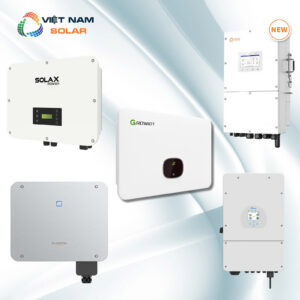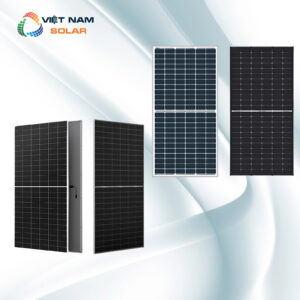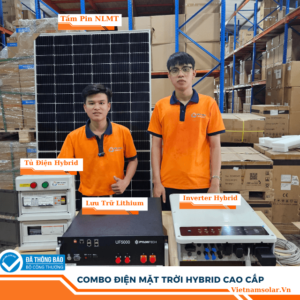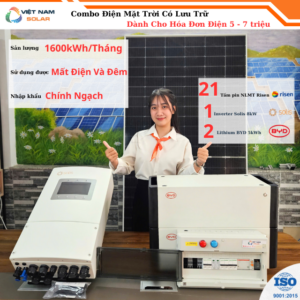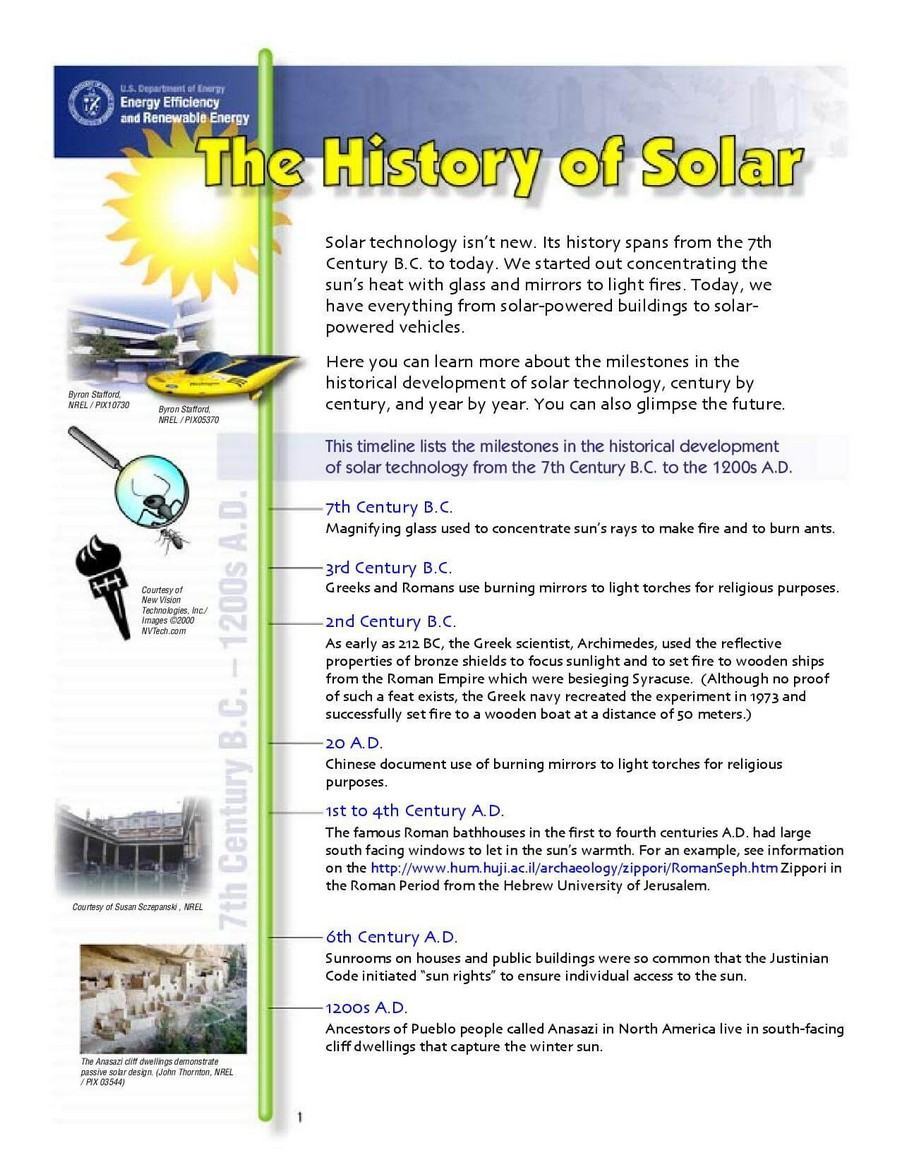
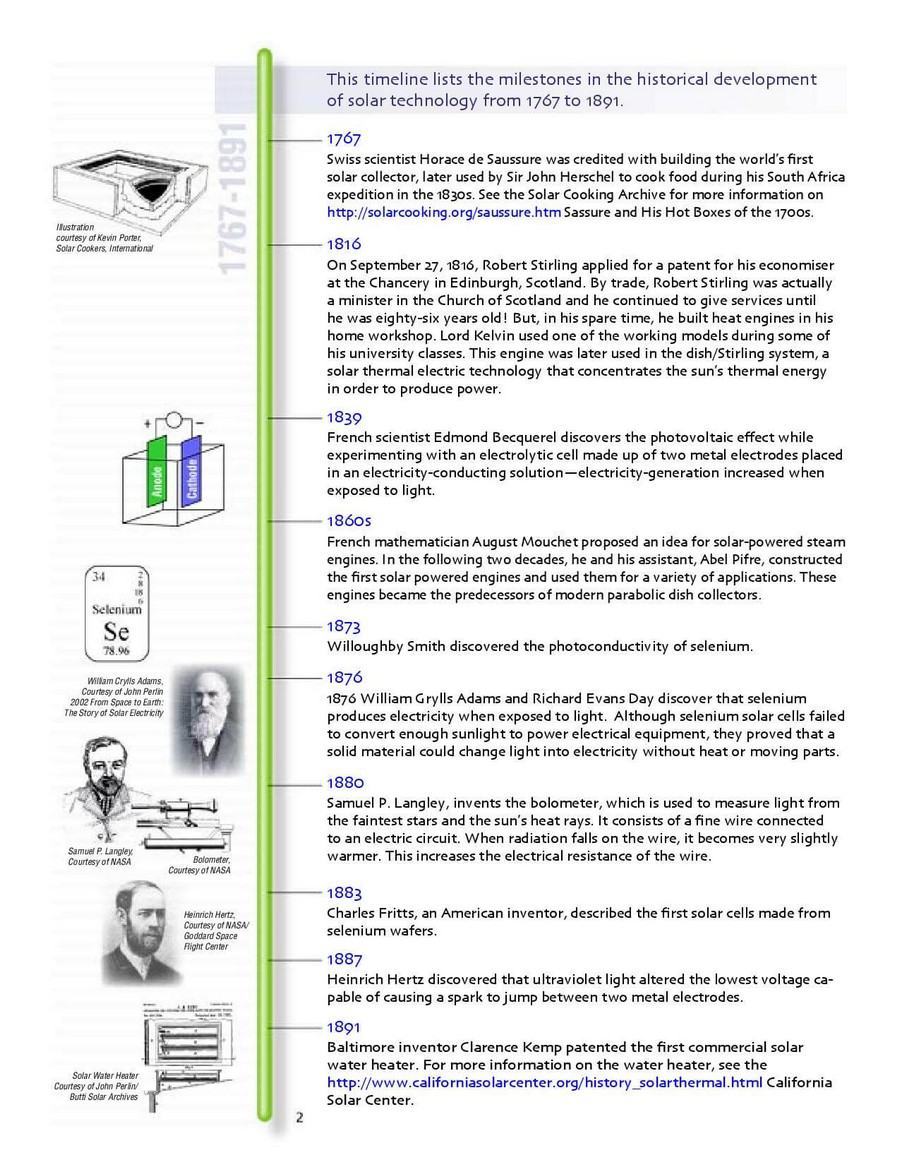
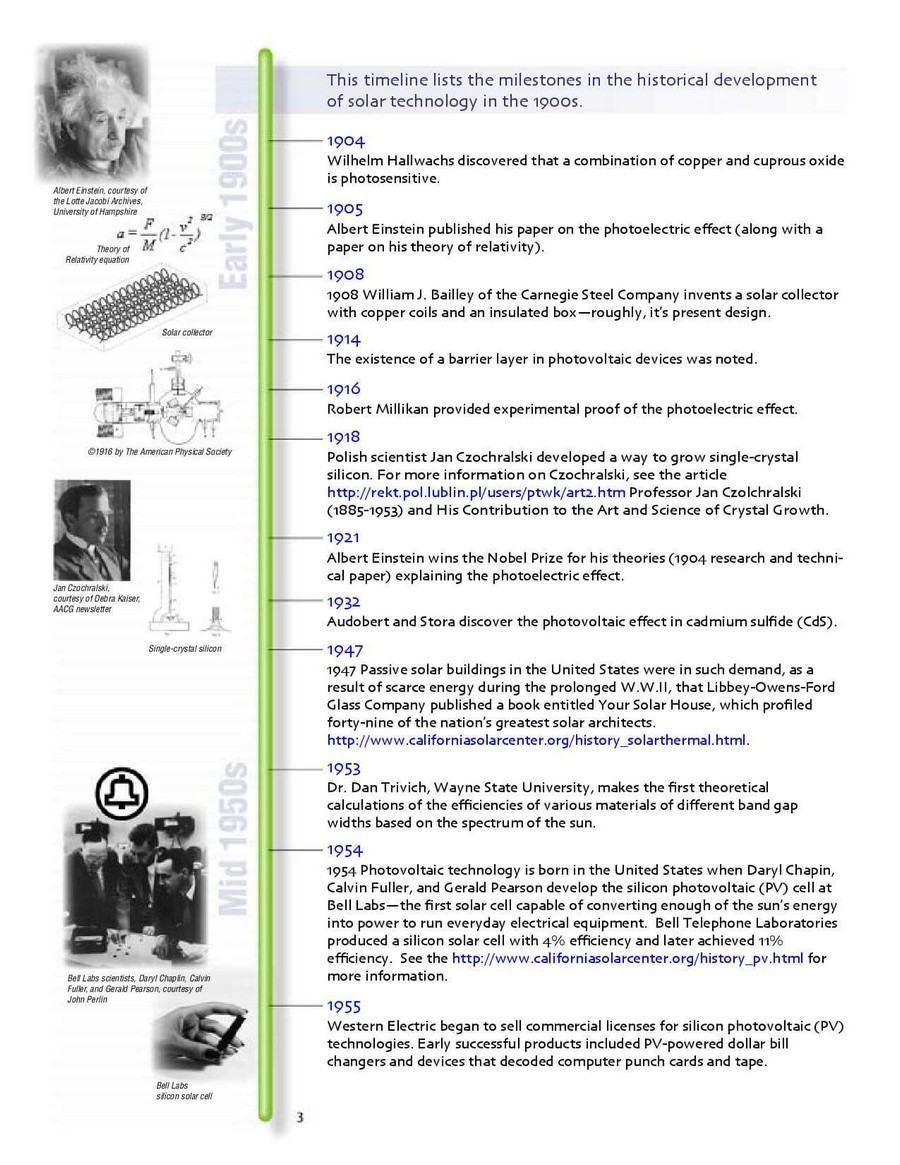
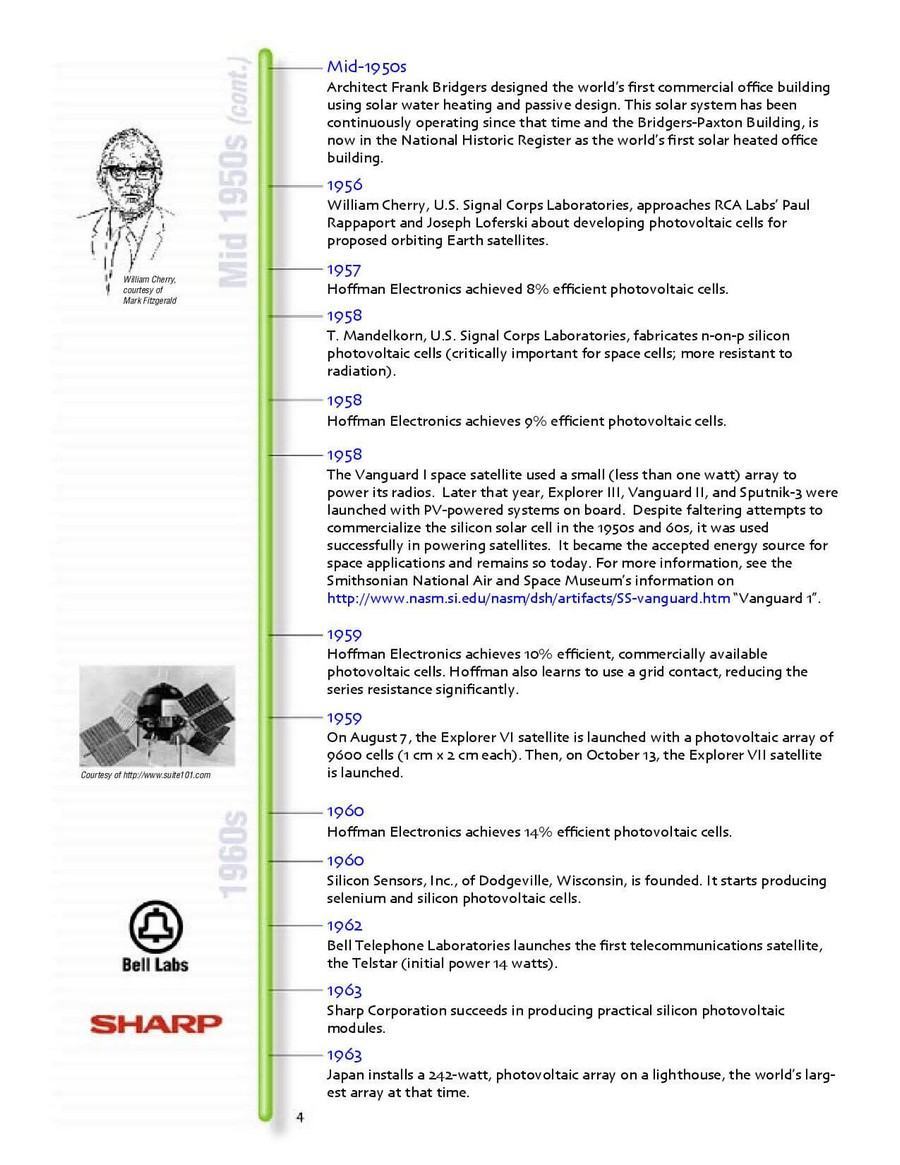
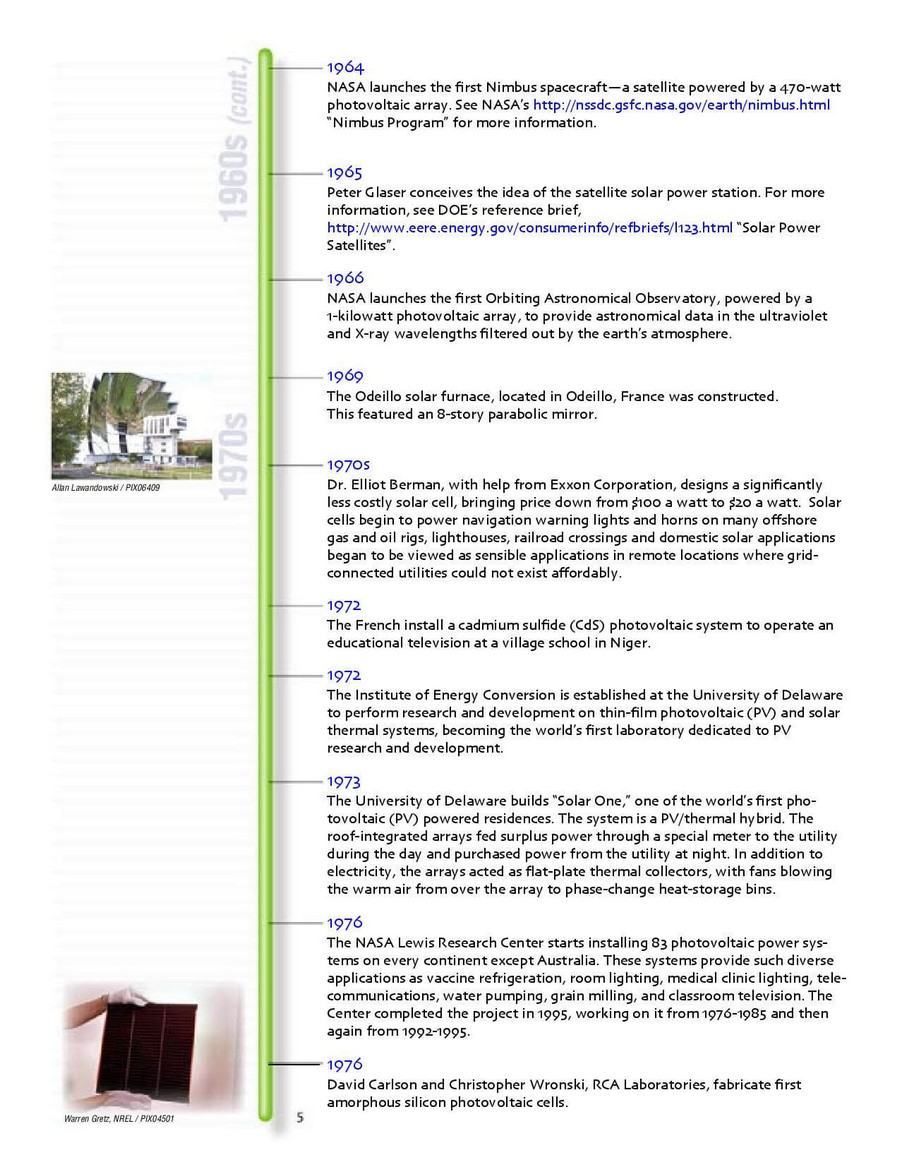
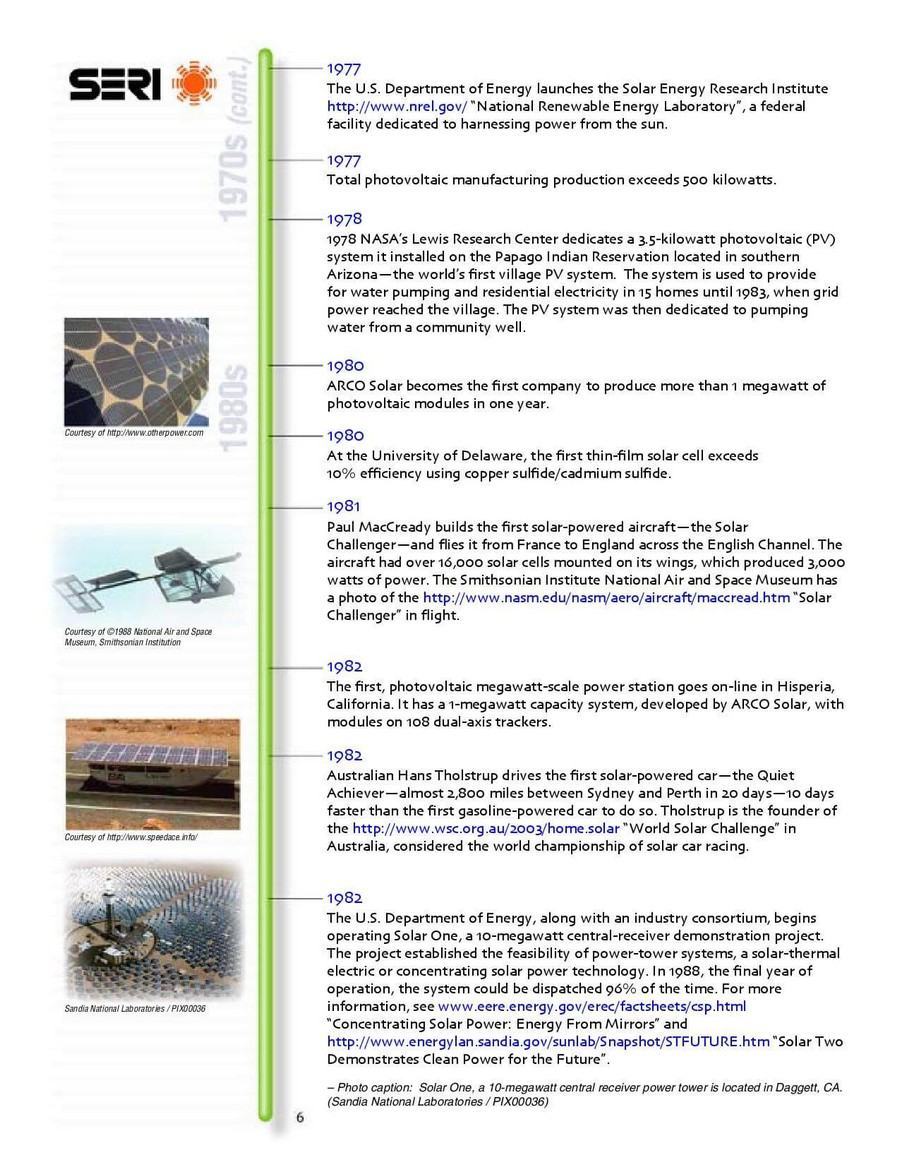
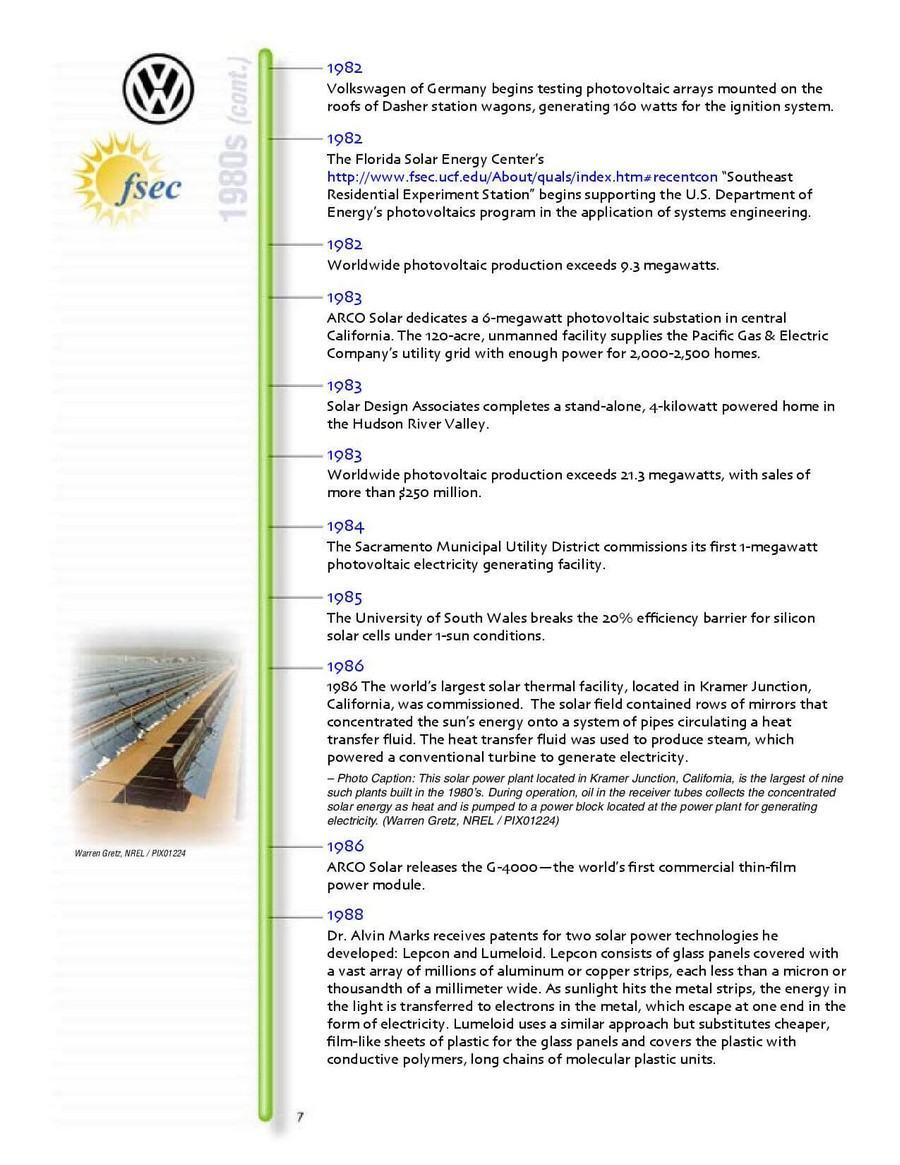
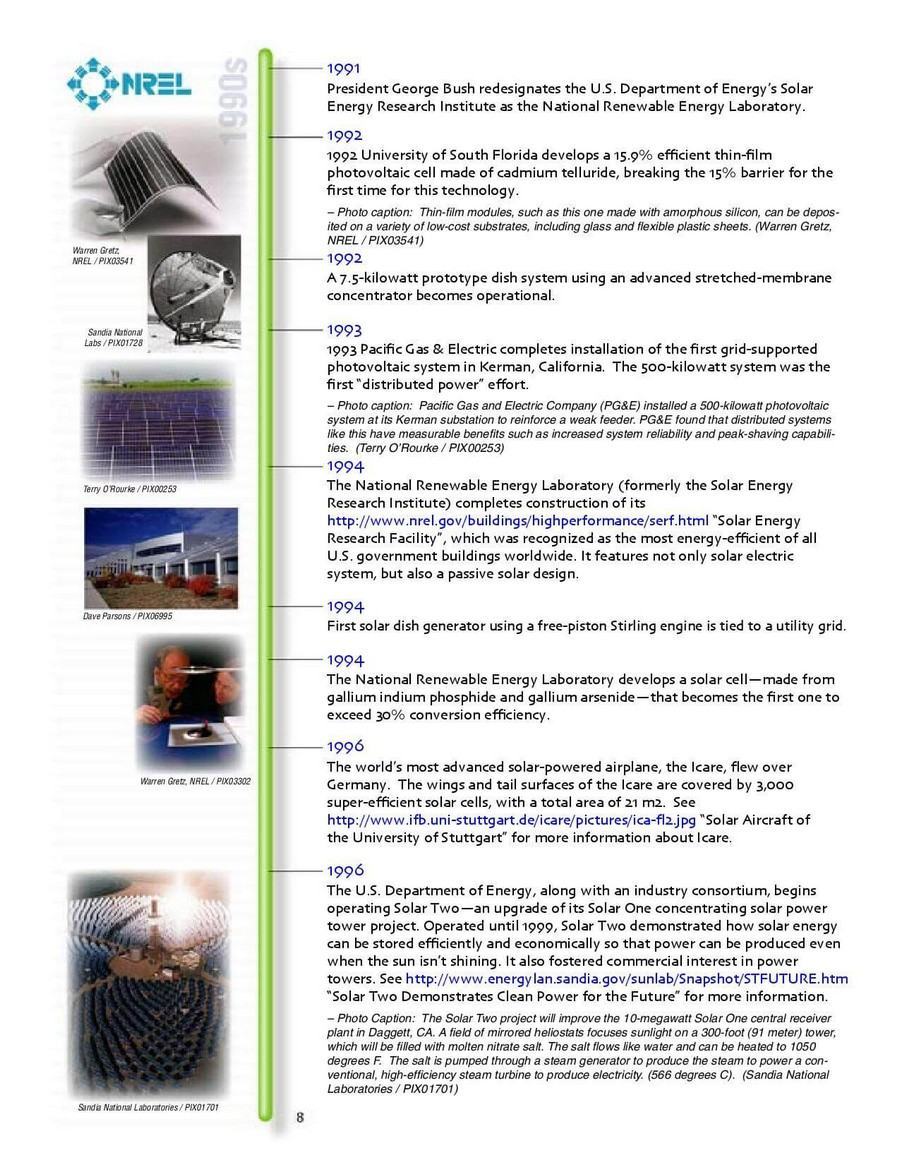
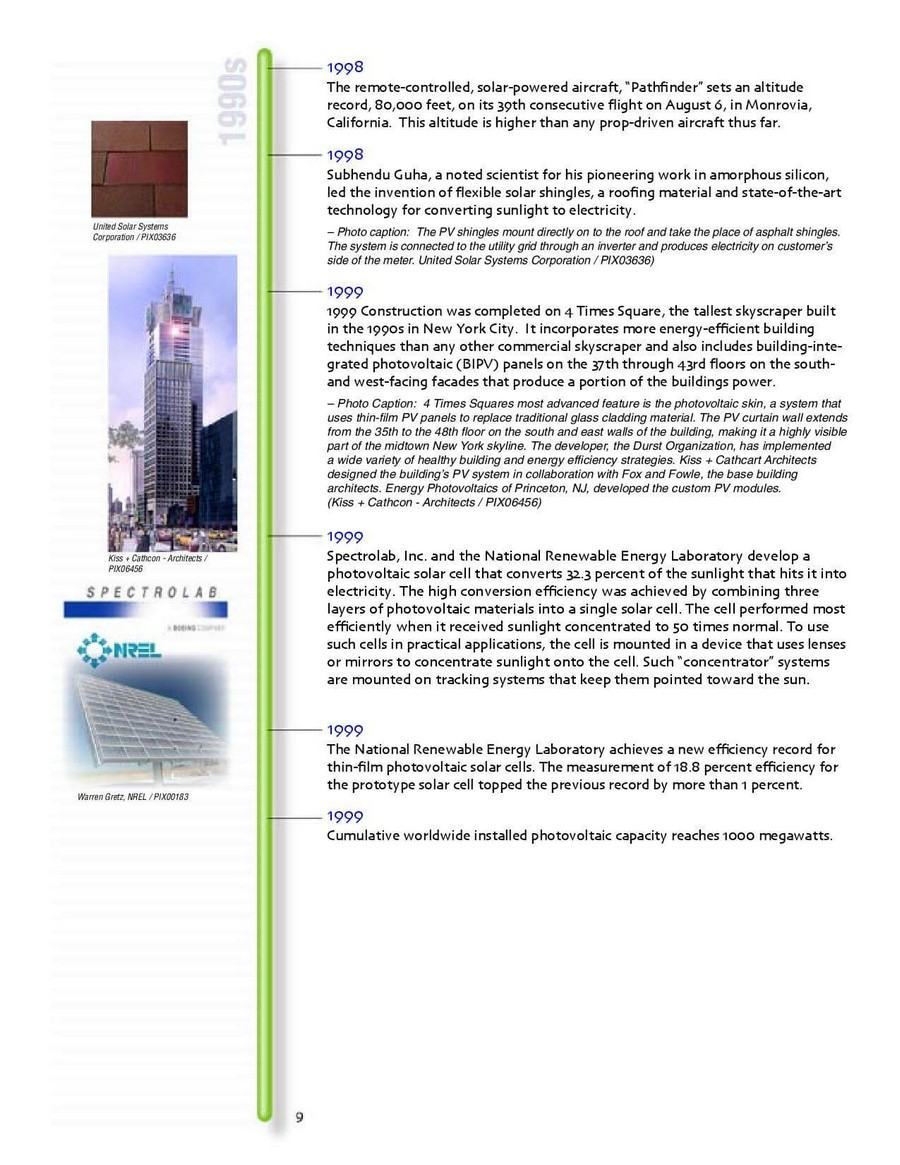
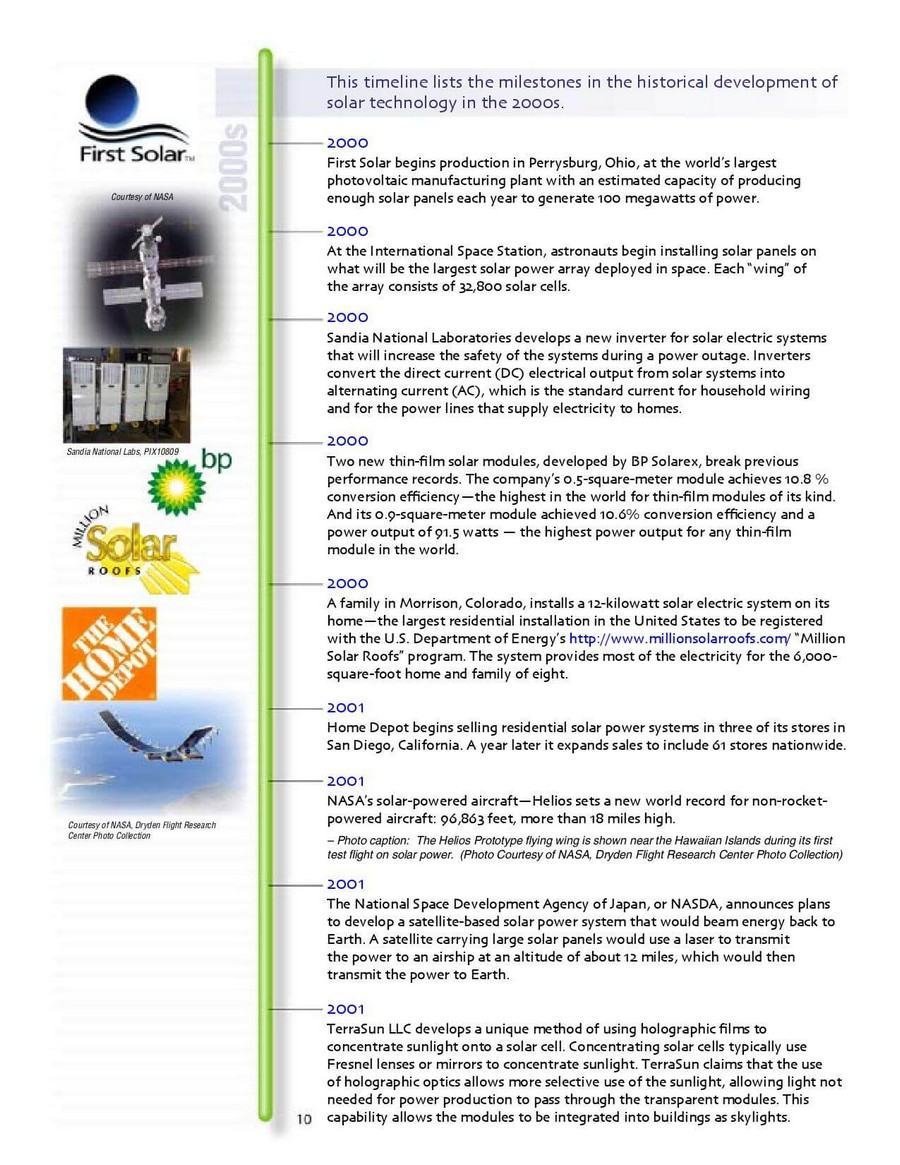
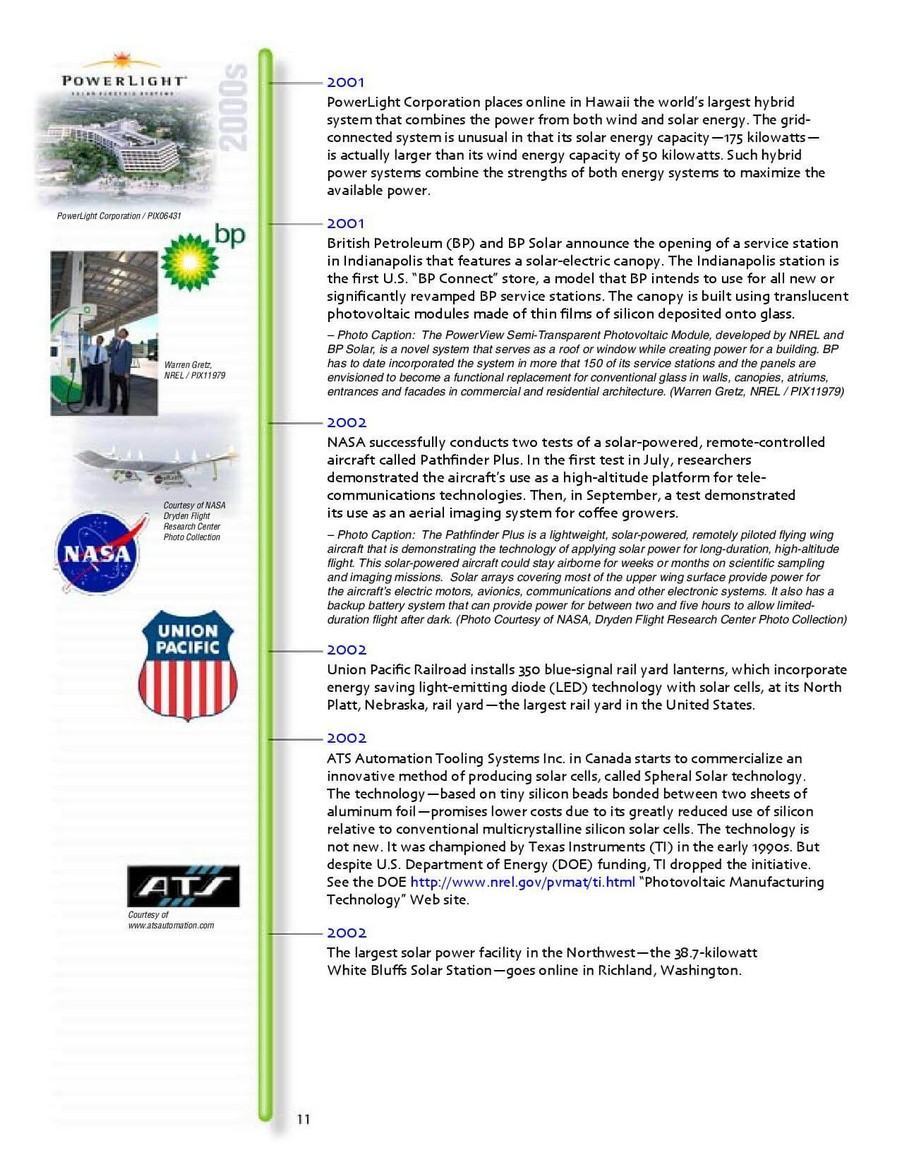
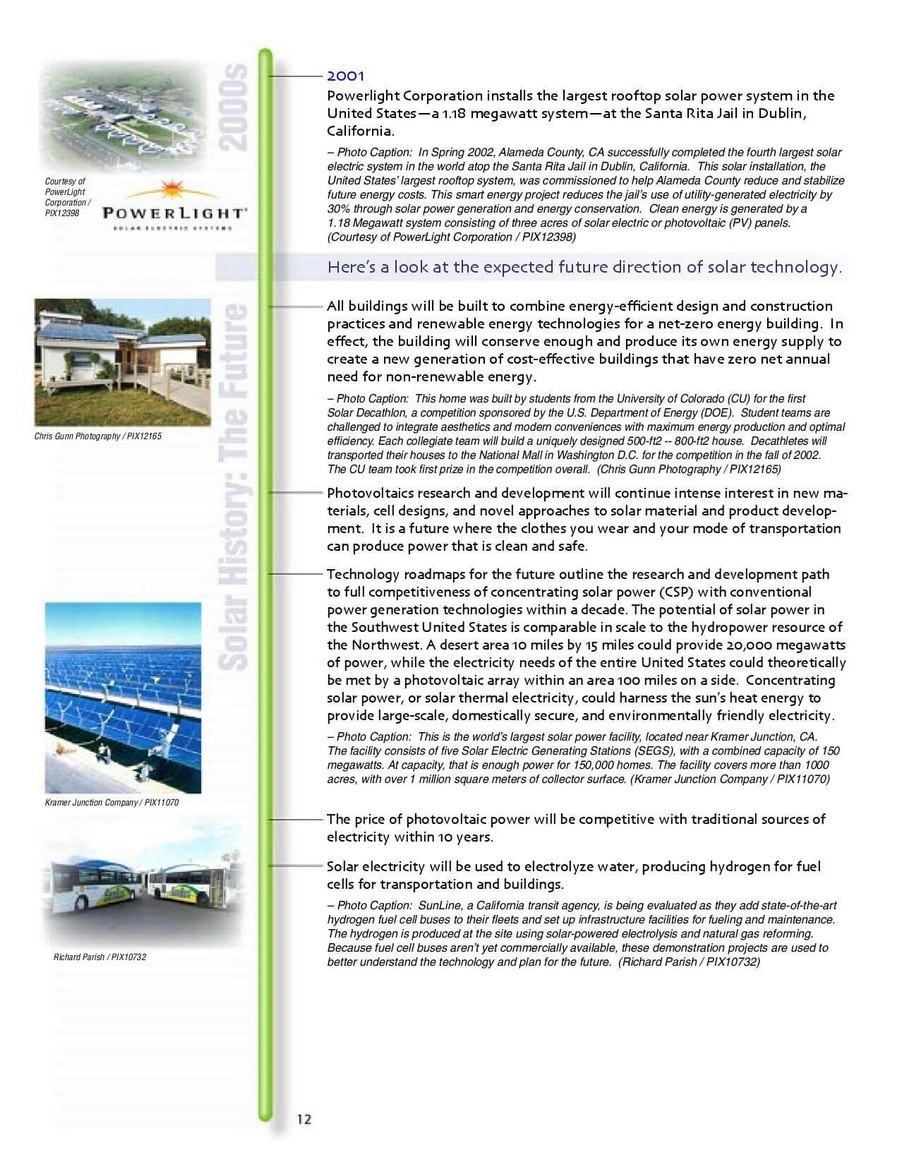
Today’s photovoltaic systems are used to generate electricity to pump water, light up the night, activate switches, charge batteries, supply power to the utility grid, and much more.
1839:
Nineteen-year-old Edmund Becquerel, a French experimental physicist, discovered the photovoltaic effect while experimenting with an electrolytic cell made up of two metal electrodes. 1873: Willoughby Smith discovered the photoconductivity of selenium.
1876:
Adams and Day observed the photovoltaic effect in solid selenium.
1883:
Charles Fritts, an American inventor, described the first solar cells made from selenium wafers.
1887:
Heinrich Hertz discovered that ultraviolet light altered the lowest voltage capable of causing a spark to jump between two metal electrodes.
1904:
Hallwachs discovered that a combination of copper and cuprous oxide was photosensitive. Einstein published his paper on the photoelectric effect.
1914:
The existence of a barrier layer in PV devices was reported.
1916:
Millikan provided experimental proof of the photoelectric effect.
1918:
Polish scientist Czochralski developed a way to grow single-crystal silicon.
1923:
Albert Einstein received the Nobel Prize for his theories explaining the photoelectric effect.
1951:
A grown p-n junction enabled the production of a single-crystal cell of germanium.
1954:
The PV effect in Cd was reported; primary work was performed by Rappaport, Loferski and Jenny at RCA. Bell Labs researchers Pearson, Chapin, and Fuller reported their discovery of 4.5% efficient silicon solar cells; this was raised to 6% only a few months later (by a work team including Mort Prince). Chapin, Fuller, Pearson (AT&T) submitted their results to the Journal of Applied Physics. AT&T demonstrated solar cells in Murray Hill, New Jersey, then at the National Academy of Science Meeting in Washington, DC.
1955:
Western Electric began to sell commercial licenses for silicon PV technologies; early successful products included PV-powered dollar bill changers and devices that decoded computer punch cards and tape. Bell System’s demonstration of the type P rural carrier system began in Americus, Georgia. Hoffman Electronics’s Semiconductor Division announced a commercial PV product at 2% efficiency; priced at $25/cell and at 14 mW each, the cost of energy was $1500/W.
1956:
Bell System’s demonstration of the type P rural carrier system was terminated after five months.
1957:
Hoffman Electronics achieved 8% efficient cells. “Solar Energy Converting Apparatus,” patent #2,780,765, was issued to Chapin, Fuller, and Pearson, AT&T.
1958:
Hoffman Electronics achieved 9% efficient PV cells. Vanguard I, the first PV-powered satellite, was launched in cooperation with the U.S. Signal Corp. The satellite power system operated for 8 years.
1959:
Hoffman Electronics achieved 10% efficient, commercially available PV cells and demonstrated the use of a grid contact to significantly reduce series resistance. Explorer-6 was launched with a PV array of 9600 cells, each only 1 cm x 2 cm.
1960:
Hoffman Electronics achieved 14% efficient PV cells.
1961:
The UN conference on Solar Energy in the Developing World was held. The precursor to the PV Specialists Conference, the Meeting of the Solar Working Group (SWG) of the Interservice Group for Flight Vehicle Power, was held in Philadelphia, Pennsylvania. The first PV Specialists Conference was held in Washington, DC.
1963:
Japan installed a 242-W PV array on a lighthouse, the world’s largest array at that time.
1964:
The Nimbus spacecraft was launched with a 470-W PV array.
1965:
Peter Glaser, A.D. Little, conceived the idea of a satellite solar power station. Tyco Labs developed the edge-defined, film-fed growth (EFG) process, first to grow crystal sapphire ribbons and then silicon.
1966:
The Orbiting Astronomical Observatory was launched with a 1-kW PV array.
1968:
The OVI-13 satellite was launched with two CdS panels.
1972:
The French install a CdS PV system in a village school in Niger to run an educational TV.
1973:
The Cherry Hill Conference was held in Cherry Hill, New Jersey.
1974:
Japan formulated Project Sunshine. Tyco Labs grew the first EFG, 1-inch-wide ribbon by an endless-belt process.
1975:
The U.S. government began a terrestrial PV research and development project, assigned to the Jet Propulsion Laboratory (JPL), as a result of recommendations of the Cherry Hill Conference. Bill Yerkes opened Solar Technology International. Exxon opened Solar Power Corporation. JPL instituted the Block I procurement by the U.S. government.
1977:
The Solar Energy Research Institute (SERI), later to become the National Renewable Energy Laboratory (NREL), opened in Golden, Colorado. Total PV manufacturing production exceeded 500 kW.
1979:
Solenergy was founded. NASA’s Lewis Research Center (LeRC) completed a 3.5-kW system on the Papago Indian Reservation in Schuchuli, Arizona; this was the world’s first village PV system. NASA’s LeRC completed an 1.8-kW array for AID, in Tangaye, Upper Volta, and later increased power output to 3.6 kW.
1980:
The first William R. Cherry Award was given to Paul Rappaport, SERI’s founding director. New Mexico State University, Las Cruces, was selected to establish and operate the Southwest Residential Experimental Station (SW RES). A 105.6-kW system was dedicated at Natural Bridges National Monument in Utah; the system used Motorola, ARCO Solar, and Spectrolab PV modules.
1981:
A 90.4-kW PV system was dedicated at Lovington Square Shopping Center (New Mexico) using Solar Power Corp. modules. A 97.6-kW PV system was dedicated at Beverly High School in Beverly, Massachusetts, using Solar Power Corp. modules. An 8-kW PV-powered (Mobil Solar), reverse-osmosis desalination facility was dedicated in Jeddah, Saudi Arabia.
1982:
Worldwide PV production exceeded 9.3 MW. Solarex dedicated its ‘PV Breeder’ production facility in Frederick, Maryland, with its roof-integrated 200-kW array. ARCO Solar’s Hisperia, California, 1-MW PV plant went on line with modules on 108 dual-axis trackers.
1983:
The JPL Block V procurement was begun. Solar Power Corporation completed the design and installation of four stand-alone PV village power systems in Hammam Biadha, Tunesia (a 29-kW village power system, a 1.5-kW residential system, and two 1.5-kW irrigation/pumping systems). Solar Design Associates completed the stand-alone, 4-kW (Mobil Solar), Hudson River Valley home. Worldwide PV production exceeded 21.3 MW, and sales exceeded $250 million.
1984:
The IEEE Morris N. Liebmann Award was presented to Drs. David Carlson and Christopher Wronski at the 17th Photovoltaic Specialists Conference, “for crucial contributions to the use of amorphous silicon in low-cost, high-performance photovoltaic solar cells.”
1991:
The Solar Energy Research Institute was redesignated as the U.S. Department of Energy’s National Renewable Energy Laboratory by President George Bush.
1993:
The National Renewable Energy Laboratory’s Solar Energy Research Facility (SERF), opened in Golden, Colorado.
1996:
The U.S. Department of Energy announces the National Center for Photovoltaics, headquartered in Golden, Colorado.
|
|
|
| Giấy phép hoạt động xây dựng | Giấy phép hoạt động điện lực | Chứng chỉ ISO 9001:2015 |
|---|---|---|
 |
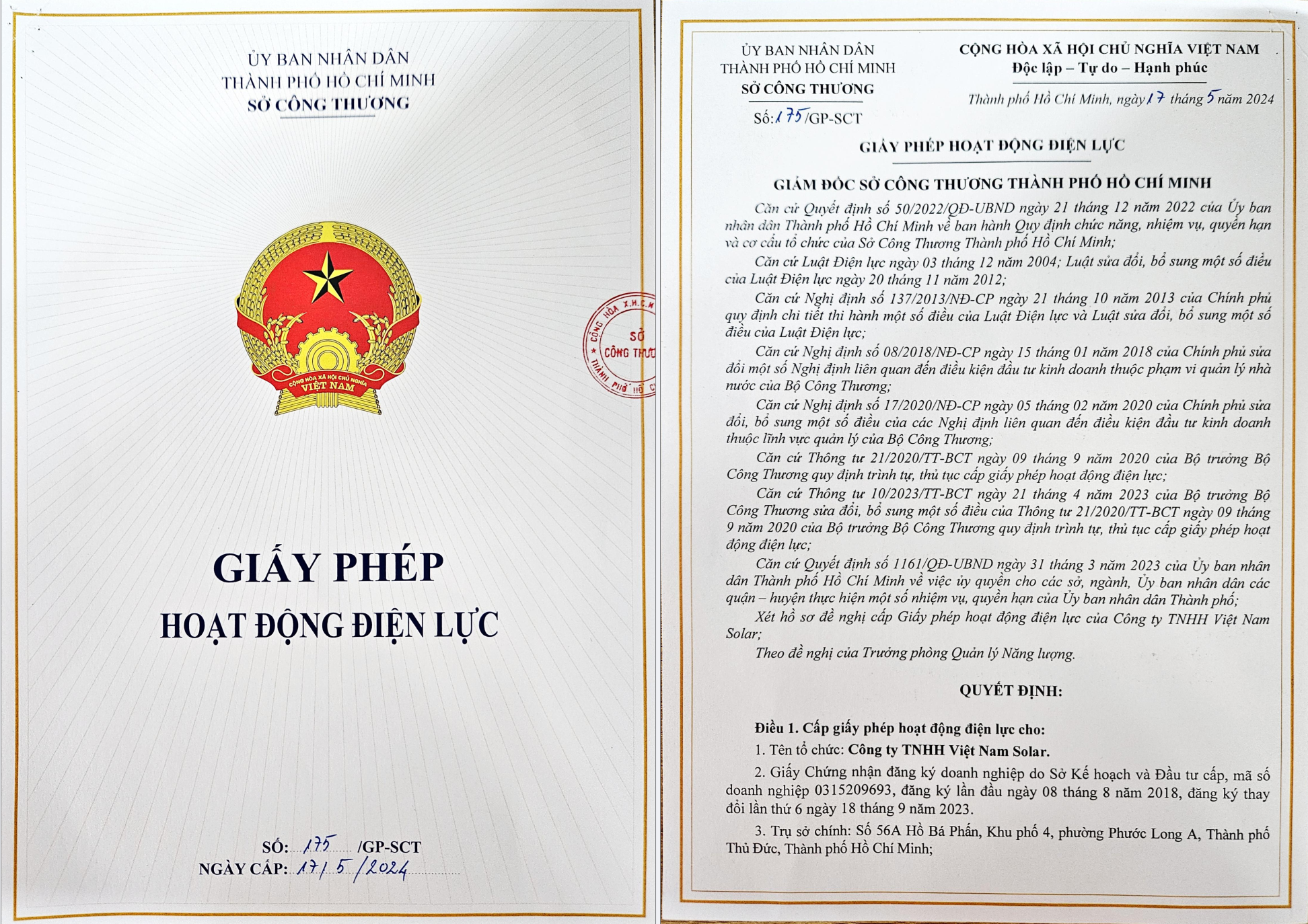 |
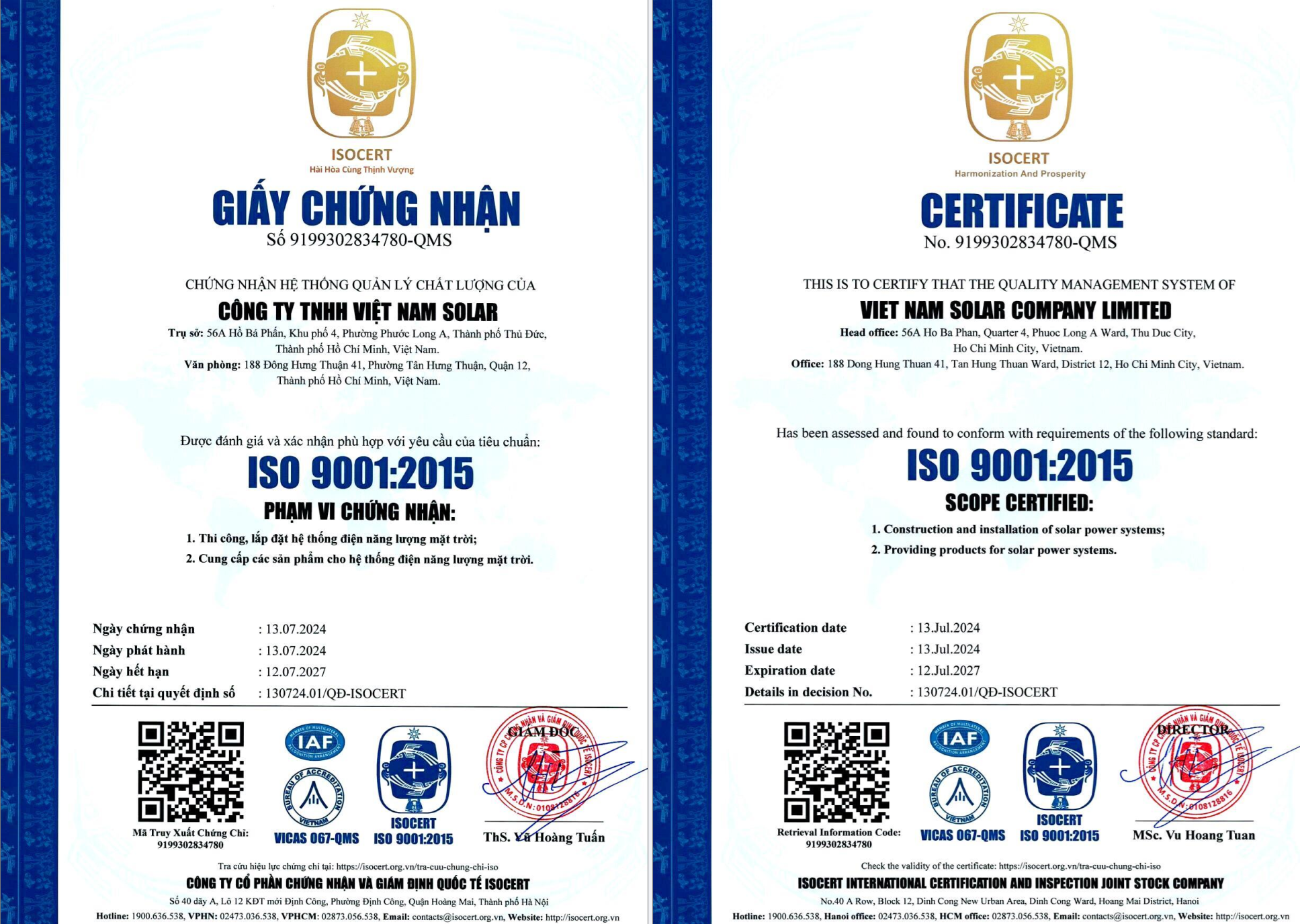 |
Video Hiển Thị Trong Giây Lát!

